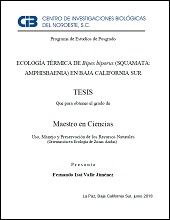| dc.contributor | PATRICIA GALINA TESSARO | |
| dc.creator | FERNANDO ISAI VALLE JIMENEZ | |
| dc.date | 2018-06 | |
| dc.identifier | https://cibnor.repositorioinstitucional.mx/jspui/handle/1001/1254 | |
| dc.identifier.uri | http://dspace.cibnor.mx:8080/handle/123456789/2687 | |
| dc.description | "La temperatura juega un papel fundamental en todos los aspectos ecológicos de los reptiles. Estos han desarrollado estrategias conductuales para mantener su temperatura corporal dentro de un intervalo óptimo y realizar sus actividades cotidianas. Este intervalo, así como sus temperaturas corporales suelen variar según las condiciones ambientales y la época del año. Los estudios de termorregulación y uso del hábitat son primordiales en el entendimiento de la ecología y los requerimientos de los reptiles, sobre todo, para anticipar los efectos que los procesos como el cambio climático y la fragmentación del hábitat puedan tener sobre sus poblaciones. Desafortunadamente, este tipo de trabajos se han concentrado solo en las especies conspicuas dejando de lado a los organismos menos evidentes como a las especies fosoriales. Estos últimos aprovechan que la heterogeneidad del suelo propicia la formación de microclimas particulares en función de las características intrínsecas del sustrato y su asociación con elementos superficiales. Para este trabajo se determinó la ecología térmica y el uso de hábitat de Bipes biporus, modelo de estudio que se eligió debido a sus hábitos secretivos, conducta fosorial y hábitat con alta variación en la temperatura a lo largo del día y del año. Particularmente, se evaluaron los índices de termorregulación propuestos por Hertz et al. (1995) durante la temporada seca (enero – junio) y lluviosa (julio – diciembre) en el “El Comitán”, La Paz, B. C. S. En campo se obtuvieron las temperaturas corporales (Tc), las temperaturas operativas (To) y datos estructurales del hábitat. En el laboratorio se evaluó la temperatura seleccionada (Tsel) utilizando un gradiente térmico vertical. La Tc de B. biporus fue de 31.9°C y el intervalo de Tsel de 26.8 a 31.4°C. Los resultados no mostraron diferencias significativas de los requerimientos térmicos entre la temporada seca y lluviosa. Para los índices se obtuvo un promedio de 4.5 para la precisión termorregulatoria, 3.2 para la calidad térmica del hábitat y un valor de -0.4 para la eficiencia térmica; sin diferencias entre las estaciones del año. Por otro lado, B. biporus tiene mayor afinidad por habitar bajo los mezquites, con una diferencia significativa con respecto de otros sustratos y no parece habitar a grandes profundidades, salvo en los casos donde la cobertura vegetal es escaza..." | |
| dc.description | "Temperature plays a fundamental role in all ecological aspects of reptiles. They have developed behavioral strategies to maintain their body temperature within an optimal range and perform their daily activities. This interval, as well as their body temperatures , usually varies according to the environmental conditions and time of year. The study of thermoregulation and habitat use are essential in understanding ecology and environmental requirements of reptiles, especially to anticipate the effects that processes such as climate change and habitat fragmentation may have on their populations. Unfortunately, this type of work has focused only on the conspicuous species leaving aside the less obvious organisms such as fossorial species that take advantage of soil heterogeneity, which favors the formation of individual microclimate depending on the intrinsic characteristics of the substrate and its association with surface elements. This study determined thermal ecology and habitat use of Bipes biporus; the, study model was chosen because of its secretive habits, fossorial behavior and habitat with high variation in temperature throughout the day and year. In particular, the thermoregulation indices proposed by Hertz et al. (1995) were evaluated during the dry season (January-June) and rainy season (July-December) for B. biporus in "El Comitán", La Paz, Baja California Sur, Mexico. Corporal temperatures (Tc), operating temperatures (To) and habitat structural elements were obtained in fieldwork. In the laboratory, the selected temperature (Tsel) was evaluated using a vertical thermal gradient. The Tc and Tsel interval of B. biporus was 31.9 °C and 26.8 to 31.4 °C, respectively. The results showed no significant differences in thermal requirements between dry and rainy seasons. For the indices, an average of 4.5 for the thermoregulatory precision, 3.2 for the thermal quality of the habitat and a value of -0.4 for the thermal efficiency were obtained. No differences were observed between seasons. On the other hand, B. biporus has a greater affinity for living under mesquites with a significant difference with respect to other substrates and does not seem to inhabit great depths, except in cases where plant cover is scarce..." | |
| dc.format | application/pdf | |
| dc.language | spa | |
| dc.publisher | Centro de Investigaciones Biológicas del Noroeste, S.C. | |
| dc.rights | info:eu-repo/semantics/openAccess | |
| dc.rights | http://creativecommons.org/licenses/by-nc-nd/4.0 | |
| dc.subject | info:eu-repo/classification/AUTOR/Bipes biporus, Termorregulación, Reptiles, Temperatura, Fosorial | |
| dc.subject | info:eu-repo/classification/AUTOR/Thermoregulation, temperature, reptiles, fossorial | |
| dc.subject | info:eu-repo/classification/cti/2 | |
| dc.subject | info:eu-repo/classification/cti/24 | |
| dc.subject | info:eu-repo/classification/cti/2401 | |
| dc.subject | info:eu-repo/classification/cti/240102 | |
| dc.subject | info:eu-repo/classification/cti/240102 | |
| dc.title | Ecología térmica de Bipes biporus (Squamata: Amphisbaenia) en Baja California Sur | |
| dc.type | info:eu-repo/semantics/masterThesis | |
| dc.type | info:eu-repo/semantics/acceptedVersion | |


